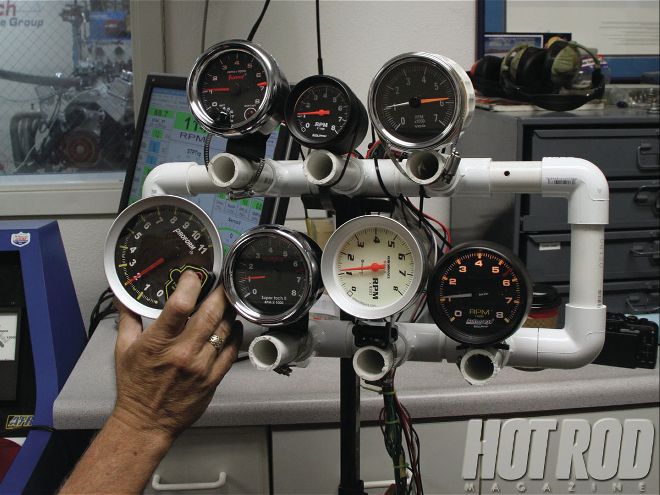
Hot Rod Proven
You Can Buy Rev Counters on the Cheap, but Are They Accurate? We Find Out.
The Premise
Every Hot Rod should have a tachometer, and if yours didn't come with one you've got a ton of options. With a Benjamin as the budget, we decided to test seven models from Summit Racing to see how accurate they are.
The Stuff
Every tach in this lineup will with work with four-, six-, or eight-cylinder engines. The least expensive one is the classic Sunpro Super Tach II at $39.95, followed by the Auto Gage at $46.95, and a Summit Racing tach with a built-in shift light for $49.95. Once you commit to spending more than 50 bucks, your choices are the VDO at $76.95, the iEquus at $79.95, a big ol 5-incher from Proform with peak rpm recall at $84.95, and the smallest-diameter tach of the bunch, an in-dash Auto Meter for $91.95.
The Test
We relied on the digital tach output of a programmable MSD Digital 7 ignition box attached to Westech Performance Group's SuperFlow 902 engine dyno to tell us how fast a small-block Chevy was spinning during our test. First, we hooked up the tachs individually to the tach output of the MSD and observed the needles at points ranging from 1,000 to 7,000 rpm. Then we connected all seven tachs to the Digital 7 box to see if it would drive them all at the same time. Remarkably, it did, enabling us to point a video camera at the tachs during a dyno pull and then slow down the video to see if any of the tachs swept across the rpm range differently.
The Results
With the engine idling at 1,000 rpm, the tachs were very accurate, with the exception of the Proform unit, which registered 1,200 rpm. At 2,000 rpm the Auto Meter was on the low side, with the needle pointing at 1,850 rpm. The Proform tach was right on the money. At the 3,000-rpm mark, the Sunpro unit was way off with a 2,750-rpm reading. The Proform tach showed 2,850 rpm, while the others were all within 50 rpm of actual engine rpm. When the engine was pulled to 4,000 rpm, the Summit Racing and VDO tachs both had low readings of 3,850 rpm while the other tachs were accurate. When 5,000 rpm came and went the Summit Racing tach was once again on the low side, with a 4,800-rpm reading, and the Sunpro tach gave us our first high reading of 5,100 rpm. Moving up into the range where it really matters, the Summit Racing gauge was down 200 rpm and the VDO was down 175 rpm at 6,000 rpm engine speed. We stopped pulling the engine at the 7,000-rpm mark because it had hydraulic lifters, and most street engines don't see that kind of rpm, anyway. The VDO was down 150 rpm, and the rest agreed with the dyno that the engine was indeed spinning at 7,000 rpm.
Conclusions
The Auto Gage and iEquus tachs were the most accurate across the operating range of our test engine. The others all had points within the range where they read low or high, but unless you've got a max-effort racing engine and need to know its exact rpm at all points, any of these tachs will do the job. Then again, if you've spent the dough for an all-out race engine, you probably have a data-acquisition system already and aren't shopping for an inexpensive tachometer.
Bottom Line
Any of these tachs is accurate enough for a street car. You just need to choose one that matches the style of your Hot Rod's interior and that physically fits the dash area.
The Test Mule
Had we attempted to bolt this many tachs into a Hot Rod, the fail police would have us in cuffs immediately. We needed an engine to test them on, so we ventured to Westech Performance to use one of its mule motors, a stout 372ci small-block Chevy. Based on a Dart SHP block with a 4.125 bore, the combo includes a 3.480-inch-stroke steel crank, H-beam rods, forged slugs, AFR 195 Street Eliminator heads, a Holley Strip Dominator intake, and a Holley 950 Ultra HP carburetor. The cam is a Comp XE hydraulic roller with 242/248 duration at 0.050- and 0.530-inch lift. It's a 10.5:1-compression package that runs on 91-octane and makes 530 hp at 6,700 rpm and 475 lb-ft of torque at 5,400 rpm.